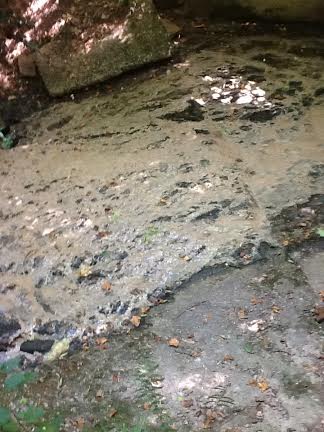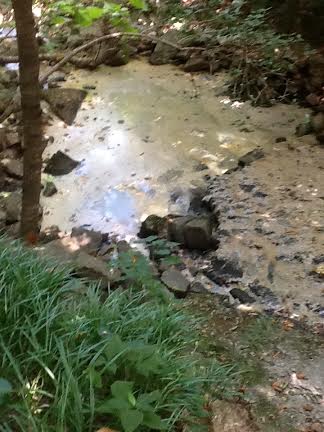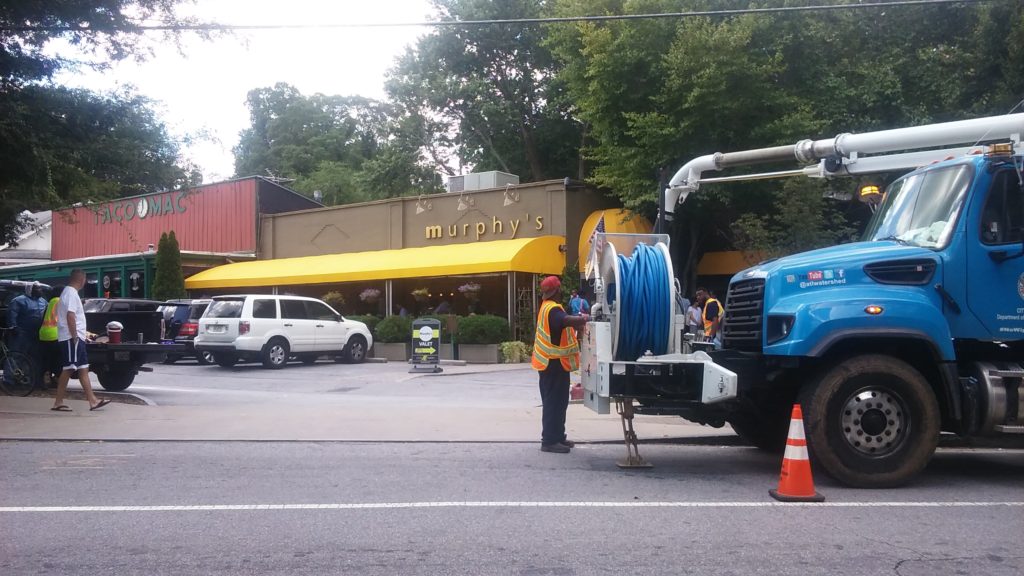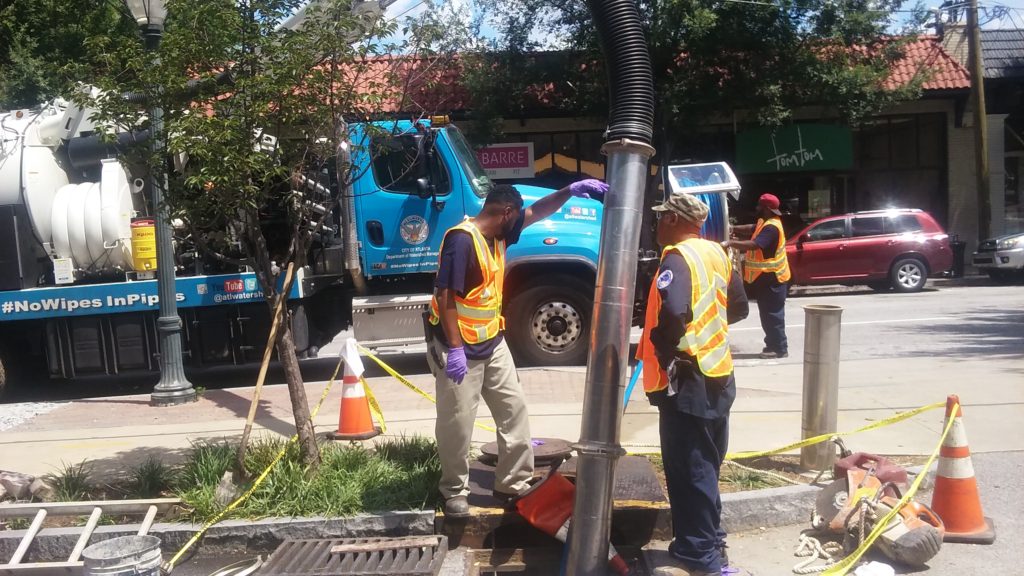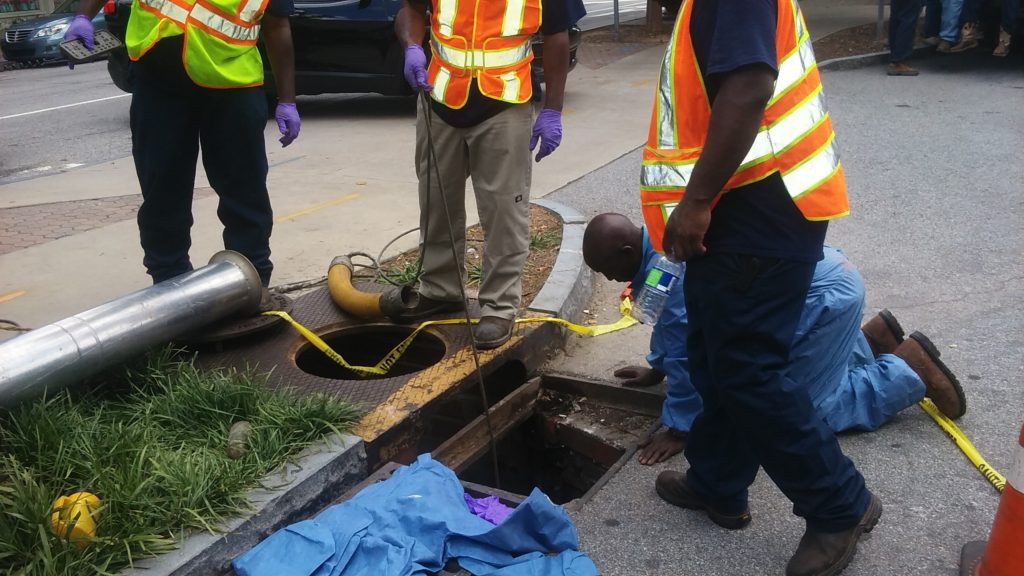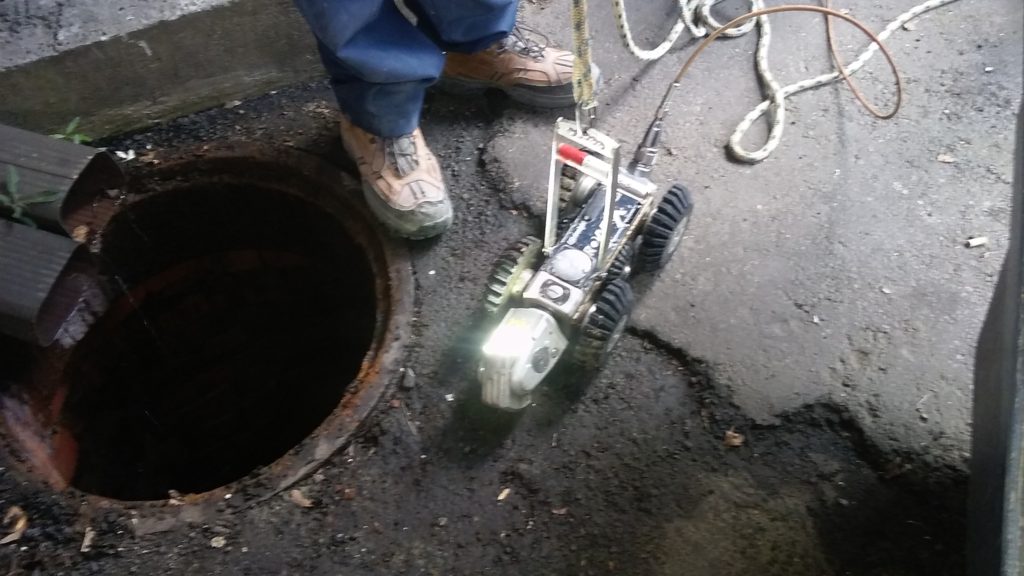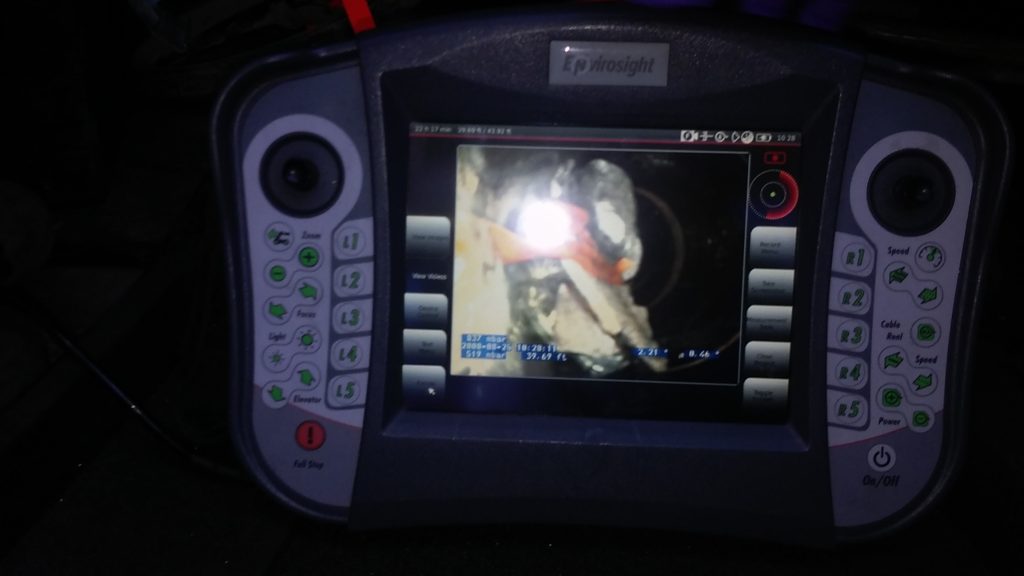Orme Creek Fouled by Grease, City’s Stormwater Recon Crew Responds
By Jack White, VHCA Board President
In the week of July 11th, some local citizens observed that the water in the creek running through Orme Park was discolored – ‘milky white’ was an early description – and had a bad odor. (The stream has no official name but is widely referred to as Orme Creek by neighbors.) The city’s Department of Stormwater Management (DWM) was notified and sent out a crew to take a water sample. On a couple of occasions in the past few years, paint has been illegally dumped in the stream (usually via a street drain), becoming visible along the length of the park. It’s a bad – and illegal act – but it usually dissipates rapidly.
A few days later the odor was worse, and VHCA Parks Chair David Brandenberger and I pushed DWM for a report on the sample they had taken and for further investigation. An up-close look revealed a gelatinous, sticky, and smelly substance that was not dissolving in water. (See photos 1 &2, taken by local resident George Petsch on July 13th.) As we all know, July had little rain, and the smattering of widely-scattered thunderstorms that did occur had missed this area altogether. Whatever was in the water was neither moving nor dissolving, and the odor was absolutely getting worse.
The persistence of the odor spurred DWM to send a crew to try to identify its source. (The assistance of Watershed Management’s Julie Owens, who immediately grasped the issue, was very helpful in this process.) This crew did not have the results of the sample taken a few days earlier (reason unknown), but they grimly speculated that the material was grease, usually produced in this quantity by commercial restaurants. They diligently searched upstream, put (harmless) dyes into the stream (that clung and illuminated the grease; see photo 3, also by VaHi resident George Petsch) and storm drains to verify their assumptions about what pipes went where. (It will be no surprise that maps of infrastructure built and revised constantly over the last century are far from perfect.) This crew walked up the large culvert under Brookridge as far as they could from Orme Park and then called in the City Reconnaissance Crew.
Note: Scroll down to bottom of article for more photos.
Searching for the source
The Recon Crew has at their command a sophisticated camera with LED lights that – conditions permitting – can travel through stormwater and sanitary pipes and provide a great view of interior conditions. That crew arrived on Friday, confirmed the grease analysis, began the ultra-laborious tasks of validating where the upstream access manholes were located, and followed the grease upstream. (They need the manholes for access; the camera doesn’t turn corners.) By Friday afternoon the trail had led them to North Highland and uphill – to the south – to the rear of the southernmost residential property on Vance Avenue, next to the parking lot behind the shops on the northwest corner of Virginia & Highland. At that point, their camera (whose lens can turn 180 degrees in two directions) had spotted from inside the pipe what appeared to be an opening cover on the surface. But aboveground, they found no manhole – only a 4’ x 5’ slab of solid concrete.
A careful hour with a concrete saw and sledge hammer removed that obstacle, whose legal reason of installation eluded everyone. It definitely made it impossible to visually inspect the stormwater drain from the surface, as well as preventing the system from accepting ground flows from the yard in the back of the adjacent apartment building.
One more camera trip took them to the rear of the building on N. Highland; there the pipe contained a lot of grease amidst trash and broken bricks capable of immobilizing the camera. The detritus was blasted out with a jet of high-pressure water. (Watching the truck maneuver in the middle the rear parking lot on Friday at 8 PM was entertaining.)
When the broken bricks were removed, the grease trail was followed under the building and across to the other side of Virginia. Subsequent searches that continued into Sunday and Monday pinpointed the source: a faulty uncapped pipe in the crawl space under Murphy’s Restaurant that was allowing grease to spill onto the ground and into the stormwater system.
Unlike the multi-day effort required to locate the problem, making the necessary repairs was not very hard, owner Tom Murphy reported.
While this process was underway and to prevent any further material already in the system from reaching the creek, the crew inserted a hose into the manhole they had uncovered behind Vance and began pumping the greasy flows out to the sanitary line on that street. Grease isn’t designed to be in the sanitary line either – it’s supposed to be carefully collected and placed in grease traps or captured by an in-line grease system and subsequently hauled away. Pumping isn’t ideal, but the grease is better off in the sanitary lines (where it will get some treatment) than in Orme Creek, the Chattahoochee River, or Apalachicola Bay, whose fish and oysters are for sale right here in Atlanta.
Fats, Oils, & Grease – a big stinky expensive problem in Atlanta
The city’s Department of Watershed Management estimates that discharges containing high concentrations of fats, oils, and grease (FOG) from commercial food vendors – restaurants, schools, nursing homes, etc. – contribute to more than half of the blockages or overflows in the city’s collection system. Grease and food byproducts in the stormwater system and streams can interfere with the nutrient balance and affect the health of vegetation and wildlife. It’s also very difficult to mitigate the damage after grease is in a waterway.
Watershed Management’s Recon Crew
The eventual repair may have been straightforward, but the effort required to diagnose and identify the problem was huge, time-consuming, and expensive. Some comments about the work ethic and esprit de corps of the Recon Crew (some of whom are pictured) are in order. A variety of citizens and board members spent parts of three days watching them deal with an important public health hzard in a stream.
Their work requires an unusual combination of gritty manual labor and the ability to use sophisticated and expensive equipment, plus a lot of experience and interpretation of sometimes uncertain data. This crew’s performance was exemplary: to a person, they were cheerful, determined, and resolute. They donned their suits and descended into cramped and smelly manholes several times while we were watching – manually pulling out some obstructions and protecting their extremely expensive camera.
If, like most of us, you are sometimes discouraged by the quality of the municipal services you receive, an hour or two with these folks will cheer you up. They were absolutely indefatigable, and they are very well informed about their mission and its importance. We owe them many thanks.
Why does it matter what gets into our local creeks?
The answer goes beyond the beauty and enjoyment that many local citizens derive from being near those streams. All natural systems are inter-related; the macroinvertebrates in the creek, the fish (there are some, even here) the insects, the birds, the mammals – their mutual health depends on one another
And these creeks flow far beyond our borders, carrying with them all our accumulated impacts.
VaHi’s subwatersheds
Virginia-Highland has two sub-watersheds, Rock Creek and Clear Creek; both eventually flow to Peachtree Creek and on to the Chattahoochee River and the Gulf of Mexico at Apalachicola Bay. Appropriately-named North ‘High-land’ Avenue is broadly the boundary between them.
Rainfall to the east of Highland flows (either underground or via several patches of surface streams) into Rock Creek, which heads north into South Peachtree in Johnson-Taylor Park in Morningside. (The very top of Rock Creek is visible behind Arlington Place and – more obviously – on both sides of Amsterdam Avenue at McLynn.)
Clear Creek – and Orme – are to the west of Highland. Rainfall there flows downhill to the west (again mostly underground; only a few sections like Orme Park are above) and into Clear Creek, which itself emerges onto the surface at the northern edge of Piedmont Park on its way to Ansley Mall and the Golf Course, under I-85, along the border of Brookwood, and into Peachtree Creek west of the Piedmont Road bridge near Lindberg Drive.
Inside its namesake park , Orme Creek is easy to observe and approach. Its surface life (low volume, like Rock Creek) begins behind houses between LA Avenue (on the south) and Glen Arden (on the north.) It collects some water from underground storm drains throughout the immediate neighborhood.
‘Combined’ sewers v. separate stormwater & sanitary systems
The system running through Orme Park is not a combined sewer system, the DWM crews report. That is, unlike much of VaHi south of Virginia Avenue, the sanitary discharges (what we flush from our homes and businesses) enter separate and distinct sanitary pipes and not the same pipes that hold stormwater from our streets and roofs.
That modern design is vastly superior, but some of our neighborhood and much of the city (including most of Clear Creek’s watershed, whose top edge is roughly the E-W MARTA line) is “combined.” Both ‘sanitary sewage’ from our homes and stormwater enter and flow though the same pipes. In days of yore, that was the cheapest and easiest practice.
And that’s the case for almost all of downtown and much of the near west side. If you followed the discussion about the leaks on the playground near Bobby Jones Golf Course this summer, a major challenge there was a faulty “combined” pipe that allowedboth stormwater and waste to peroclate to the the surface.
Absent heavy rainfall, those combined flows go peacefully to the RM Clayton Treatment Plant, where the waste is cleaned before the water is returned to the Chattahoochee.
While the combined pipes are big enough to handle many storm events, really big ones – or several small ones in a row – can be too large for the pipes to the treatment plant to hold. When that happens, the excess overflows are designed to go into the huge tunnels that the city built in the last decade. There they are lightly treated and emptied, so they can handle the next storm.
Clear Creek’s tunnel is off Monroe Drive inside Piedmont Park. The tunnel fills up several times a year. (the exact number is uncertain); if the rain/stormwater is still coming when the tunnels is full, the overflow goes into Clear Creek itself.
Those tunnels cost a fortune, and they are why we are paying the nation’s highest water bills. It’s the tunnels, not the water, that are so costly – as are the pumps and other equipment they require, whose maintenance and replacement has caused several city council members a lot of public budget vexation. The silt in our streams that settles in the tunnels has been a difficult problem; silt doesn’t pump well.
Specific data about water quality in Orme Creek
The Chattahoochee Riverkeeper has created a nice citizen-based network – the Neighborhood Water Watch – for volunteers who periodically collect samples from local streams and transport them to the Riverkeeper office, where they are analyzed and the results are published. The city and some other agencies also do some testing, but this initiative is a good way to get local info from a lot of spots the city doesn’t get to.
And it’s a cool and useful program that involve local citizens. In Orme Park, Clair Ritchie and her family have been collecting samples for some time; to see results from their efforts at the park, go to: https://chattahoochee.org/our-work/water-monitoring/neighborhood-water-watch/. Two-thirds of the way down the page, click the link entitled NNW DATA, and scroll down to ‘Orme Creek at Orme Park.’
Many thanks to the entire Ritchie family for their work in this regard. If anyone would like to volunteer to do the same for Rock Creek, please let us know. The Riverkeeper offices are about 20 weekday afternoon minutes away near the west end of 10th street.
Here are some photos of the City’s Recon crew in action. They were something to watch, let me tell you.
